NLE's floating school casts anchor in Lagos Lagoon
Here's a look at one of the standout projects from Designs of the Year 2014 - a floating school on a Nigerian lagoon by architecture studio NLÉ (+ slideshow).
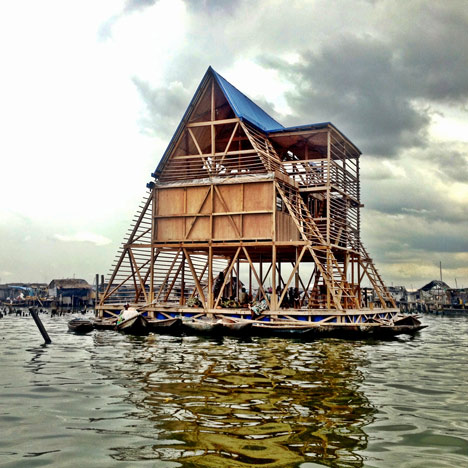
NLÉ, the studio founded by Nigerian-born architect Kunlé Adeyemi, developed the Makoko Floating School as a prototype for building in African regions that have little or no permanent infrastructure, thanks to unpredictable water levels that cause regular flooding.

Half-building, half-boat, the floating structure provides teaching facilities for the slum district of Makoko, a former fishing village in Lagos where over 100,000 people live in houses on stilts. Prior to this the community had just one English-speaking primary school that regularly found itself under water.
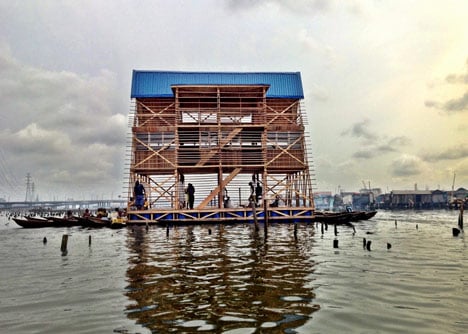
"In many ways, Makoko epitomises the most critical challenges posed by urbanisation and climate change in coastal Africa. At the same time, it also inspires possible solutions and alternatives to the invasive culture of land reclamation," said the architects.
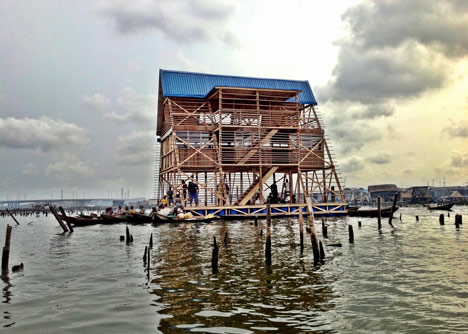
NLÉ developed a structure that can accommodate up to 100 adults, even in bad weather conditions. It is primarily used as a school, but can also function as an events space, a clinic or a market, depending on the needs of the community.
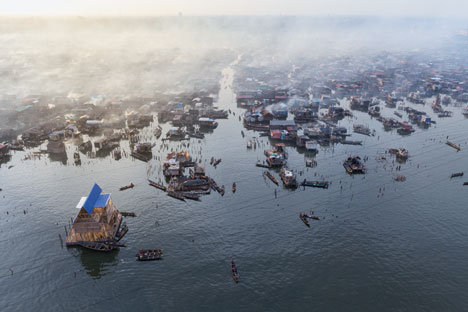
Built by a team of local residents, the structure was put together using wooden offcuts from a nearby sawmill and locally grown bamboo.
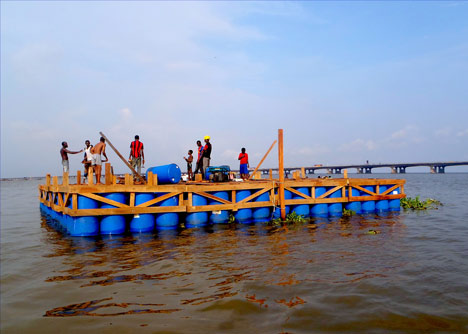
A triangular profile allows the building to accommodate three storeys whilst remaining stable over the water. "It is an ideal shape for a floating object on water due to its relatively low centre of gravity, which provides stability and balance even in heavy winds," said the designers.
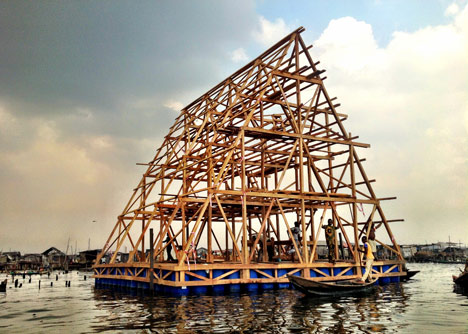
The lower level houses a space for play, while a sub-dividable space on the middle floor accommodates up to four classrooms and the upper level contains a small group workshop. A staircase on one side connects the three levels.
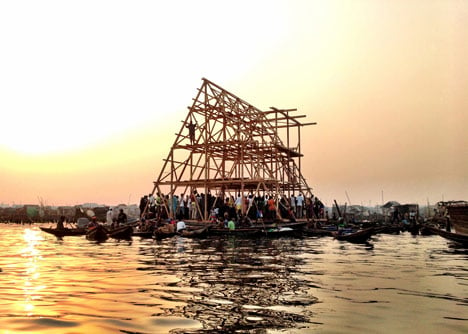
Here's the project description from NLE:
Makoko Floating School
Makoko Floating School is a prototype structure that addresses physical and social needs in view of the growing challenges of climate change in an urbanising African context. It is a movable 'building' or 'watercraft' currently located in the aquatic community of Makoko in the lagoon heart of Africa's second most populous city - Lagos, Nigeria. It is a floating structure that adapts to the tidal changes and varying water levels, making it invulnerable to flooding and storm surges. It is designed to use renewable energy, to recycle organic waste and to harvest rainwater.
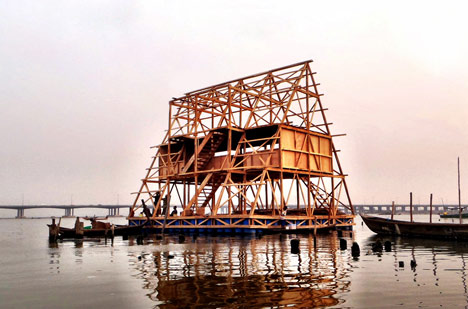
An estimated 100,000 people reside in Makoko in housing units built on stilts. Yet the community has no roads, no land and no formal infrastructure to support its day-to-day survival. In many ways, Makoko epitomises the most critical challenges posed by urbanisation and climate change in coastal Africa. At the same time, it also inspires possible solutions and alternatives to the invasive culture of land reclamation.
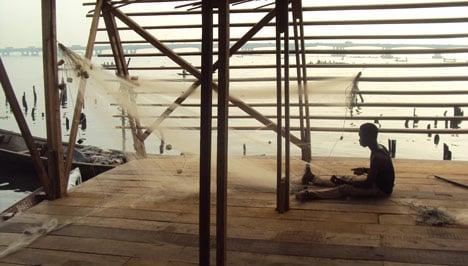
Until now Makoko has been served by one English-speaking primary school, built on uneven reclaimed land, surrounded by constantly changing waters. Like many homes in Makoko, this has rendered the primary school building structurally precarious and susceptible to recurrent flooding. Sadly, the inability of the building to effectively withstand the impact of increased rainfall and flooding has frequently threatened local children's access to their basic need – the opportunity of education.
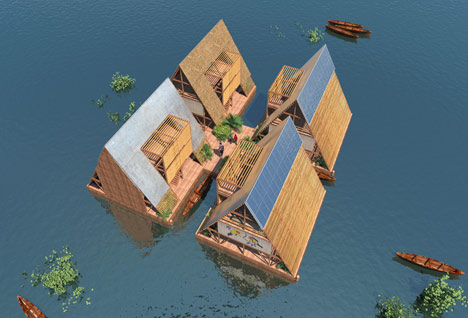
In response to this and in close collaboration with the Makoko community, NLÉ has developed a prototype floating structure that will serve primarily as a school, whilst being scalable and adaptable for other uses, such as a community hub, health clinic, market, entertainment centre or housing. The prototype's versatile structure is a safe and economical floating triangular frame that allows flexibility for customisation and completion based on specific needs and capacities.
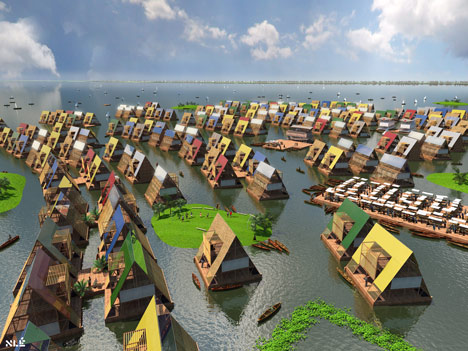
The 220m A-frame or pyramid building is 10m high with a 10m x 10m base. It is an ideal shape for a floating object on water due to its relatively low centre of gravity, which provides stability and balance even in heavy winds. It also has a total capacity to safely support a hundred adults, even in extreme weather conditions.
The building has three levels. The 1st level is an open play area for school breaks and assembly, which also serves as a community space during after hours. The 2nd level is an enclosed space for two to four classrooms, providing enough space for sixty to a hundred pupils. A staircase on the side connects the open play area, the classrooms and a semi enclosed workshop space on the 3rd level.
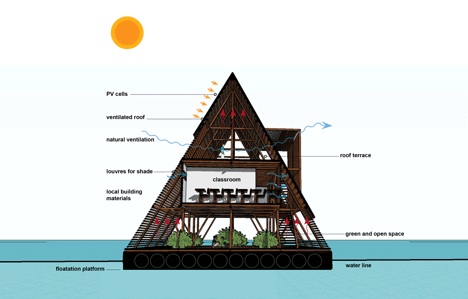
The simple yet innovative structure adheres to ideal standards of sustainable development with its inclusive technologies for renewable energy, waste reduction, water and sewage treatment as well as the promotion of low-carbon transport. Furthermore a team of eight Makoko-based builders constructed it using eco-friendly, locally sourced bamboo and wood procured from a local sawmill.
Construction began in September 2012 with floatation mock-ups and testing. Recycled empty plastic barrels found abundantly in Lagos were used for the building's buoyancy system, which consists of 16 wooden modules, each containing 16 barrels. The modules were assembled on the water, creating the platform that provides buoyancy for the building and its users. Once this was assembled, construction of the A-frame followed and was completed by March 2013. Makoko Floating School is now in regular use by the community as a social, cultural and economic centre and will soon welcome its first pupils for use as a primary school.
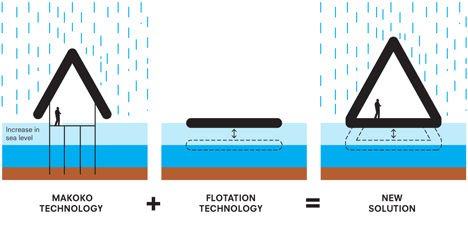
The project was initiated, designed and built by NLÉ in collaboration with the Makoko Waterfront Community, in Lagos State. The project was initially self-funded by NLÉ and later received research funds from Heinrich Boll Stiftung as well as funds for its construction from the UNDP/Federal Ministry of Environment Africa Adaptation Programme (AAP).
Makoko Floating School is a 'prototype' building structure for NLÉ’s proposed 'Lagos Water Communities Project' and its 'African Water Cities' research project.